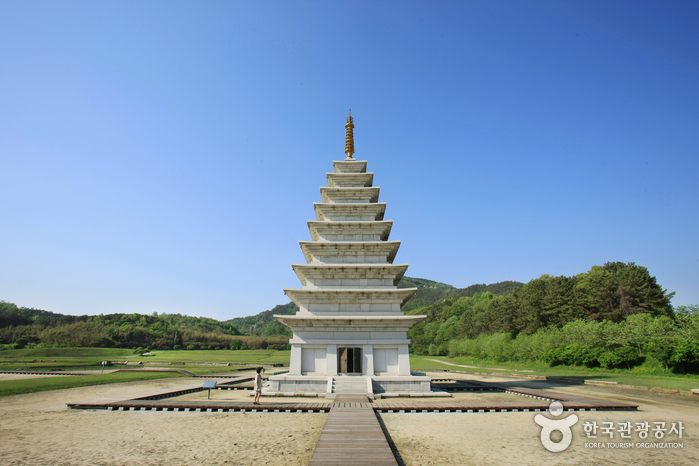Mireuksa was the largest Buddhist temple of the ancient Baekje Kingdom (18 BC-660 AD). According to Samgukyusa (historical records published in 1281), King Mu (30th king of Baekje, in power 600-641 AD) and his wife Queen Seonhwa were said to have seen a vision of Mireuksamjon (the three Sanskrit) emerging from a large pond. At the time of their revelation, the king and queen were on their way to visit a Buddhist monk in Sajasa Temple on Yonghwasan Mountain (now known as Mireuksan Mountain). In response to their vision, the king drained the nearby pond and established Mireuksa Temple. The temple is believed to have shown the most advanced architectural and cultural skills of Baekje, Silla, and Goguryeo (the three main kingdoms at that time). Records indicate that King Jinpyeong of Silla even sent his craftsmen over to assist with the temple construction.
The two main features of the Mireuksa Temple Site are the stone pagoda (Mireuksaji Seoktap) and the flagpole supports (Mireuksaji Dangganjiju). The 14.24-meter-high west stone pagoda (National Treasure No. 11) is the oldest and largest Korean stone pagoda in existence. The west pagoda currently has only six tiers, but is estimated to have originally had nine. The nine-story east stone pagoda (27.67m in height) was restored to its original stature in 1993 based on historical records. Other surviving landmarks include the flagpole supports (Treasure No. 236) to the south of the stone pagodas. The 395 centimeter-tall poles are estimated to have been created during the Unified Silla period (676-935 AD) and are set 90 meters apart from east to west.
Address
362, Mireuksaji-ro, Iksan-si, Jeollabuk-do
전라북도 익산시 금마면 미륵사지로 362
Operating Hours
[Mireuksaji Museum] 09:00-18:00
Closed
[Mireuksaji Museum] New Year’s Day, Mondays

